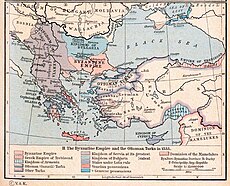
Back الاحتلال النمساوي المجري لصربيا Arabic Österreichisch-Ungarische Besetzung Serbiens 1915–1918 German Ocupación austrohúngara de Serbia Spanish Occupation austro-hongroise de la Serbie French K. u. k. Militärverwaltung in Serbien Italian სერბეთის ოკუპაცია ავსტრია-უნგრეთის მიერ Georgian Австроунгарска окупација на Србија Macedonian Ocupația austro-ungară a Serbiei 1915-1918 Romanian Австро-венгерская оккупация Сербии Russian Vojna generalna uprava u Srbiji Serbo-Croatian
 Austro-Hungarian troops in the streets of Belgrade during the occupation | |
| Date | 1 January 1916 – 1 November 1918 (2 years, 10 months, 4 weeks and 1 day) |
|---|---|
| Location | Territory of the Kingdom of Serbia west of the Morava Valley |
| History of Serbia |
|---|
 |
|
|
The Austro-Hungarian Armed Forces occupied Serbia from late 1915 until the end of World War I. Austria-Hungary's declaration of war against Serbia on 28 July 1914 marked the beginning of the war. After three unsuccessful Austro-Hungarian offensives between August and December 1914, a combined Austro-Hungarian and German offensive breached the Serbian front from the north and west in October 1915, while Bulgaria attacked from the east. By January 1916, all of Serbia had been occupied by the Central Powers.
Serbia was divided into two separate occupation zones, an Austro-Hungarian and a Bulgarian zone, both governed under a military administration. Germany declined to directly annex any Serbian territory and instead took control of railways, mines, and forestry and agricultural resources in both occupied zones. The Austro-Hungarian occupation zone covered the northern three-quarters of Serbia. It was ruled by the Military General Governorate of Serbia (MGG/S), an administration established by the Austro-Hungarian Army on 1 January 1916 with a military governor at its head, seconded by a civil commissioner. Emperor Franz Joseph I appointed Johann von Salis-Seewis, an officer born in Croatia, as the first Military Governor General. The goal of the new administration was to denationalise the Serb population and turn the country into a territory from which to draw food and exploit economic resources.
In addition to a military legal system that banned all political organizations, forbade public assembly, and brought schools under its control, the Austro-Hungarian Army was allowed to impose martial law, practice hostage-taking, burn villages in punitive raids and respond to uprisings with public hangings and summary executions. During the occupation, between 150,000 and 200,000 men, women and children were deported to purpose-built internment and concentration camps in Austria-Hungary, most notably Mauthausen in Austria, Doboj in Bosnia, and Nagymegyer, Arad and Kecskemét in Hungary.
In September 1918, Allied forces, spearheaded by the Serbian Second Army and the Yugoslav Volunteer Division, broke through the Salonica front, leading to the surrender of Bulgaria on 30 September, followed by the quick liberation of Serbia and the retreat of all remaining Austro-Hungarian troops by the end of October. By 1 November 1918, all of pre-war Serbia had been liberated, bringing the occupation to an end.
© MMXXIII Rich X Search. We shall prevail. All rights reserved. Rich X Search